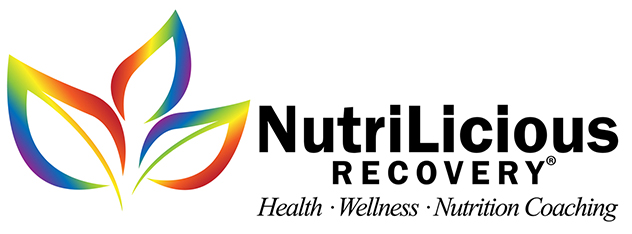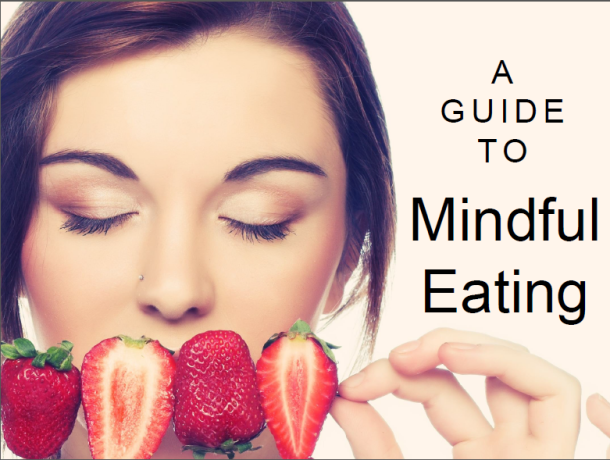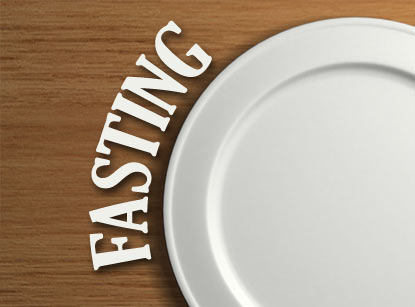
by dnshah | May 30, 2020 | Age Defying, Diet and Weight Loss, Health and Wellness Tips, Obesity, Stress Management, Virus
I’ve recently attended a fasting summit workshop (virtually), and learned quite a bit more about fasting that my Indian culture and background always hinted at.
Fasting has been happening since the beginning of man – the cavemen and women were cycling through periods of feasting and famine. All religions of the world have some time period where food is restricted or one is asked to limit it for a given time duration. This is not a new subject. What is new is that this act of food restriction seems to provide real benefits with autoimmune conditions provided that some conditions structure the practice:
Some of the other findings show that fasting:
So is fasting a go for everyone? No, there are some categories of folks that fasting a not an option for, including:
- People on certain medication (meds for diabetes, seizures, and steroids)
- People with diabetes type I
- Pregnant or nursing women
- Infants and young children
- People with eating disorders
- Anyone severely underweight
- Women who experience symptoms of hormonal imbalance after starting intermittent fasting: irregular periods, moodiness, irritability; lower calorie consumption can disrupt hormones, which are required for ovulation and a healthy pregnancy
- Extreme athletes
- Women on their menstrual cycle
If your doctor thinks it could be a good options for you to try intermittent fasting, seek out a health coach to help you on this journey, because there are some tweaks to enhance the benefits from fasting!

by dnshah | May 4, 2020 | Diet and Weight Loss, Health and Wellness Tips
Ghee is becoming more mainstream, as it keeps popping up on newer anti-inflammatory recipes … but what is it? Ghee is a highly clarified butter with all the milk solids removed. This means that certain dairy proteins are removed (like casein and whey), and certain milk sugars are removed (like lactose). This is the traditional fat of many Indian households; my mother made it for her household; and today I make it for my household. It doesn’t seem to be laborious, but is time-consuming; and of course I have short-cutted the process! There are slight nutritional content and taste differences also. The main take-away from this information is that compared to butter: ghee is more nutrient dense, is shelf-stable (doesn’t require refrigeration), has a higher smoke point, and when made correctly – it is free of casein, whey, and lactose. It an acceptable food for those that are lactose-intolerant or sensitive to dairy proteins casein or whey.
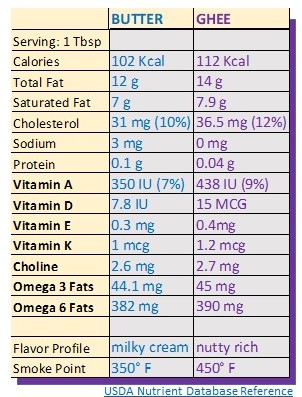
Store-bought ghee varies brand to brand on how much casein, whey, and lactose still resides in their end product. There are some brands that batch-test and are suitable for those with sensitivities or intolerance.
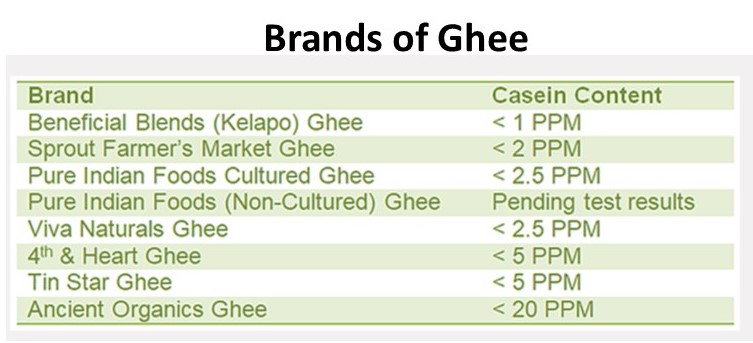
Beneficial blends ghee is one of the best choices for those sensitive to dairy proteins (casein or whey). I don’t get any special favors from them for saying so!
Alternatively homemade ghee is not difficult if you have time to make it. Here’s the best way I know to make it:
INGREDIENTS
- 1 pound (454 g) butter, preferable pastured, grass-fed, organic, & unsalted.
METHOD
- Preheat the oven to 225° F.
- Peel the butter out of the packaging, and place in a large heavy oven-safe bowl.
- Place the bowl into the heated oven.
- Cook for 2 hours. Note: Some of the milk solids may foam to the surface and brown. Bubbling may occur with the foaming, and you may smell a nutty buttery aroma while the water evaporates from the butter. All normal!
- Turn the oven off, and allow it to cool somewhat before handling.
- Remove the bowl from the oven, and skim off the top crust of the milk solids with a strainer or slotted spoon, and discard those solids.
- The remaining mixture is a yellow liquid (ghee) with a white/brown milk solid on the bottom. The white/brown solid is what needs to be removed from this bowl.
- If the milk solids on the bottom are amber/brown, you can begin the separation; otherwise return the bowl to the oven and allow it to continue gently cooking longer until the bottom portion is amber/brown in color. Ensure the milk solids don’t burn.
- Once the milk solids are amber/brown, allow the butter mixture to cool slightly at room approximately 10 minutes.
- Line a large mesh strainer or metal colander with a fine cheesecloth/nut bag/or color-safe fabric, and set the lined strainer over a large metal/glass bowl (heat-safe).
- Slowly and carefully pour the top yellow layer (ghee) into the lined strainer & bowl ensuring that the white/amber milk solids do NOT pour in accidentally. Slow & steady is the trick!
- When you get to the danger zone (when the milk solids may pour), stop pouring the ghee. Set the remainder milk solids + small layer of ghee mixture down for later.
- Transfer the already poured ghee into a clean Mason jar with a lid.
- If you have sensitivities to dairy, you are done. Discard remaining mix that has milk solids in it.
- If you don’t have dairy sensitivities, then you can still get more ghee out of the remaining mix with the following steps.
- Carefully pour the remaining milk solids+ small layer of ghee into a taller glass/ bowl with lid.
- Remove the bowl from the refrigerator. Note that the ghee will have solidified at the top. The milk solids are liquid at the bottom. In order to remove most of the milk solids, use a knife to create a hole from top to bottom (removing a corner will give you the best angle), and tilt the bowl over the sink to discard the milk solids underneath the solid ghee. The ghee should remain firmly as one surface sheet, while the bottom solids should leak out of the hole created.
- Now you are left with a sheet of solid ghee and leftover milk solids which are stuck on the bottom and not able to escape.
- Heat the remaining milk solid residue/ghee mixture in the microwave to liquefy once again.
- Now this mixture can either be used up first (if there is only a small amount left) or place mixture in the refrigerator once again.
- Repeat steps 17-20 until the portion remaining can be used up at one time for a particular dish.
- The ghee in the Mason jar is a pure ghee mixture, free from casein, whey, and lactose. The remaining ghee/milk solids mixture may not be completely free from casein, whey, and lactose but it is good enough to be used in place of butter for any recipe, provided there are no sensitivities/intolerances to butter.
- Ghee is shelf-stable for up to 3 months, or refrigerator-stable for up to 1 year.

by dnshah | May 4, 2020 | Age Defying, Diet and Weight Loss, Health and Wellness Tips, Obesity, Stress Management
Sounds awful… but many are enhancing their cup of Java – not for flavor, but to increase health benefits. There are several different ideas floating around… Mushroom coffee is one that seems to have gained popularity, as now some cafes across the country are carrying it.
Mushroom coffee is basically a regular coffee that has been combined with powerful medicinal mushrooms, such as cordyceps, lion’s main, and chaga, to boost health benefits and brain function. Can there really be merit to this fad?
Benefits
Side Effects
One should ALWAYS consult their doctor before taking any supplements.
- Mushroom coffee can interact with various drugs and prescription medications.
- For some people, the caffeine in coffee can cause jitteriness, nervousness, insomnia, and nausea. For some people, mushroom coffee can cause IBS type of symptoms.
- There are rare cases of side effects with medicinal mushroom supplements. One example of an adverse reaction involves Reishi mushrooms. It was linked to fatal hepatitis for a small percentage of consumers. Researchers attribute this to some interaction with prescription medications.
Special note that this is a new concept to the US, and mushroom coffee has not been studied directly in controlled scientific studies, so optimal dosages for coffee in combination with medicinal mushrooms have not been established. Nutritionists have referred to the recommended doses of coffee and respective mushrooms separately to create this products for the effective purpose of boosting immunity and cognitive function.
Available Products
I believe mushroom coffee is great during flu season (or a pandemic/endemic) or for anyone with a compromised immune system due to its immune-boosting properties. I especially like the easy delivery system for those of us with a daily habit of a hot beverage in the mornings. I don’t get any incentives for talking about these products, but I do use the last one mentioned!
- Four Sigmatic Mushroom Coffee Mix is ideal if you want to swap in mushroom coffee into an already-established coffee routine, and can be made with any standard coffee maker. You can even use it to make a cold brew if that’s what you prefer.
- SOLLO Chaga Immunity is a K-cup style mushroom coffee that combines arabica coffee with chaga mushroom extract.
- Four Sigmatic Mushroom Coffee Instant Mix is best-suited for making instant coffee on the go. It contains a blend of lion’s Mane, chaga, rhodiola and instant coffee powder.
- Super Organics Energy Boost Coffee uses fair trade and organic coffee with extracts of cordyceps maca root, other herbals, and probiotics.
- Naturealm Mushroom Coffee Creamer (what I use) is a dairy-free creamer (coconut milk) with a blend of maitake, cordyceps, and lion’s mane, so you can turn your favorite coffee beans into a mushroom coffee. If you typically don’t use a coffee creamer, then this is not for you.
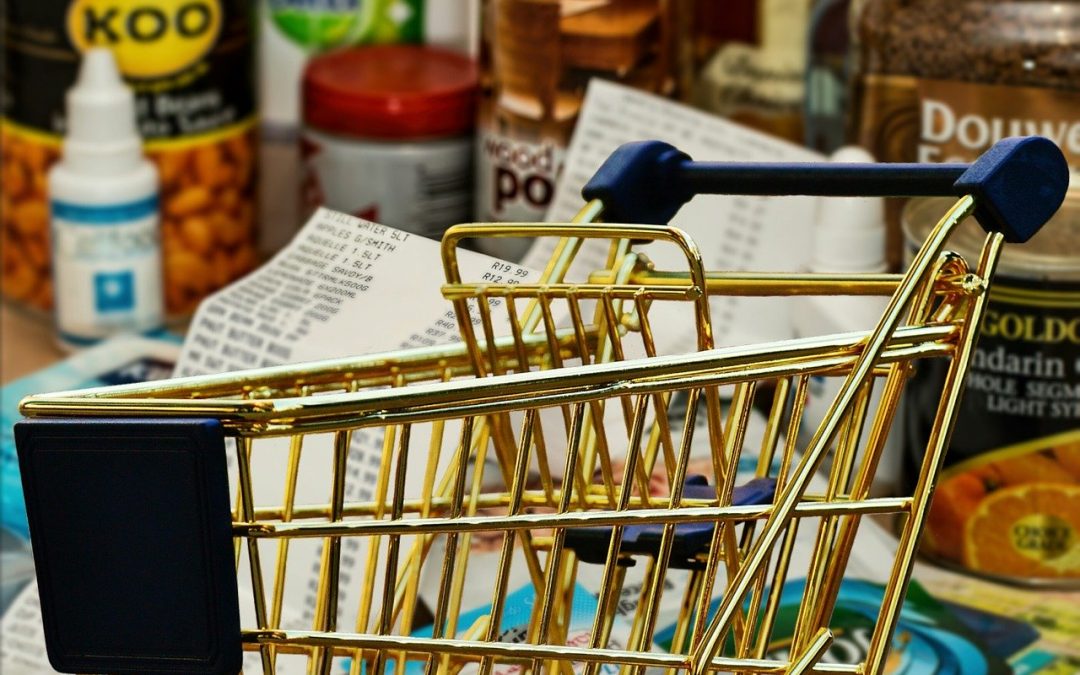
by dnshah | May 4, 2020 | Health and Wellness Tips, Virus
By Alya Azar
With over 3.5 million confirmed global cases of COVID19 and almost 250K deaths (as of May 4, 2020), this pandemic has changed the way we live. In our “new normal”, people are social distancing, wearing masks, shopping differently and cleaning differently. Here is some insight on shopping and cleaning in an endemic situation.
Strategic tips for our “new normal”:
- Getting food is essential; but we can limit grocery trips by making weekly or bi-monthly lists to ensure completeness and prevent stock shortages.
- Current shopping guidelines for some states indicate only one person from a household should go to the store to limit exposure.
- Wash your cloth bags EACH time you use them, or opt for the plastic store bags.
- Practice social distancing while shopping – Greet friends from afar, wear masks.
- The CDC does NOT recommend glove use for shopping; however if you choose to wear gloves while shopping, they must be properly removed and disposed in a trash can.
- Carry your own wipes or use the store wipes to clean your cart handle and hands before using payment cards.
- KEEP YOUR HANDS AWAY FROM YOUR FACE!
- Touch only the item you will buy – nothing additional.
- Do not touch your phone while shopping (prevent contamination).
- Aim for self-checkout where available to minimize contact
- Use wipes to clean hands and payment cards after using.
- Wash your hands for at least 20 seconds with soap/water after reaching home.
- There is NO evidence of food packaging associated with COVID19 transmission at this time, but you can wipe down external packaging of items (with mild 1% bleach solution) and allow it to air dry as a precaution.
- Many people are opting to unpack their groceries just outside the home (or in a garage), and discarding the plastic grocery bags there. Reusable cloth bags must be washed each trip.
- Refrigerate/ freeze perishables (meat, milk, berries, greens, etc.) in 20 minutes of arriving home.
- Disinfect countertops used for unpacking groceries with approved cleaners. Depending upon the cleaner you choose, you may need to leave the counters wet for 3-5 minutes before rinsing.
- Wash your hands with soap/water again when finished with groceries, or using the bathroom, or cleaning, or before eating.
- When using the bathroom, close the toilet lid before flushing as particle droplets can spread up to 6 ft at flushing with the lid open. (COVID19 can shed the virus in stool)
- When bathroom cleaning, don’t forget to unplug electric devices before beginning. Then remember to deep clean areas often forgotten: include light switches, door knobs, sink areas people touch, showerheads, shower curtains, around toilet seat, hair dryers, electric toothbrushes, shavers.
- BEFORE EATING, wash fruits/veggies with water, and for cans, clean lids before opening.
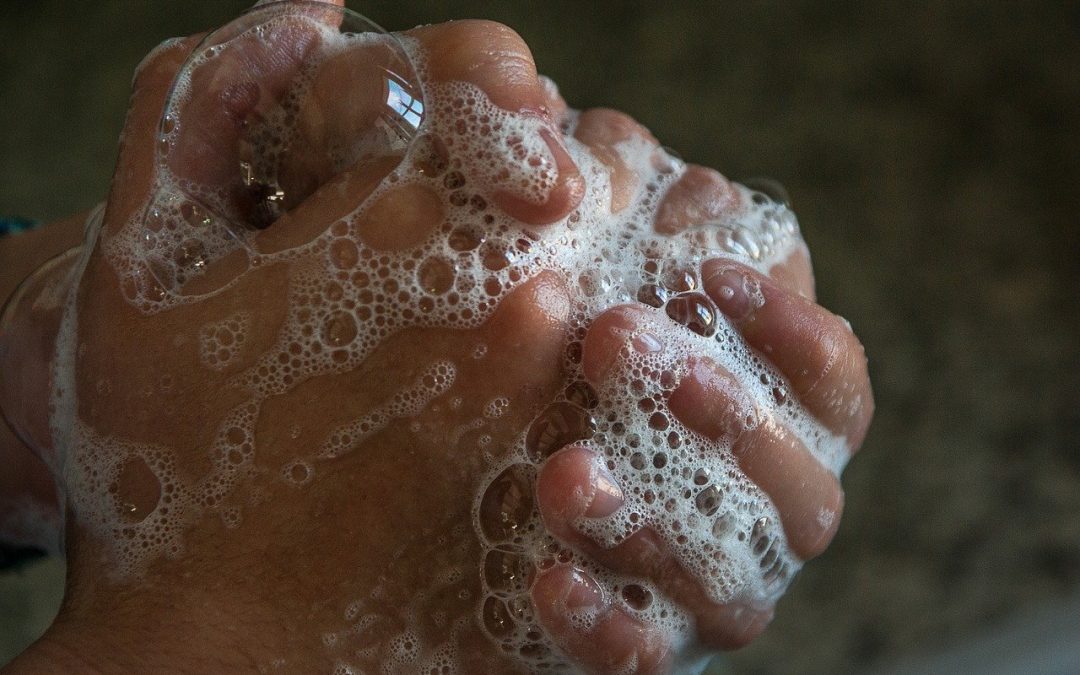
by dnshah | Apr 2, 2020 | Health and Wellness Tips, Virus
The whole world is suffering through this COVID19 pandemic. We all want to know how we can prevent getting this virus. The experts say it’s fairly simple…. But it’s eluded the whole world. The simple rule is to keep your hands free of the virus at all times, and never touch your hands to face unless they have been freshly washed. Yes, it sounds simple; but in actuality… it is the hardest thing to do. This is why it has eluded the whole planet.
The prevention formula = hands free of virus + don’t touch face unless hands are clean
Keeping Hands Free of Virus
While your hands need not be clean as you are doing tasks, the things is that you must wash them thoroughly before touching your face. And if you, like me, have a subconscious habit of itching your nose, pushing your hair off your face, or rubbing your fingers across your chapped lips; well then you may need to keep your hands clean WHILE you are doing work too. So this means you will need to keep the hand sanitizer available and use it after you push that elevator button, open a door knob, push that grocery cart, receive that take-out meal, check for mail, or process the mail, etc. If you don’t have hand sanitizer (like many), then you must be vigilant about NOT touching your face until you get the opportunity to wash your hands.
Don’t Touch Face Unless Hands Clean
Before you satisfy that itchy nose, those hands need to be thoroughly clean. This means at least a 20second- hand washing hygiene with a soap that foams. It consists of washing the fronts and back of the palm, thumb, interlacing fingers, and wrist. Once your hands are clean, you can touch your face again. The second you touch or pick up something else, you can’t touch your face until washed again.
Since most people are washing their hands numerous times per day, we also should be moisturizing at the end of each day.
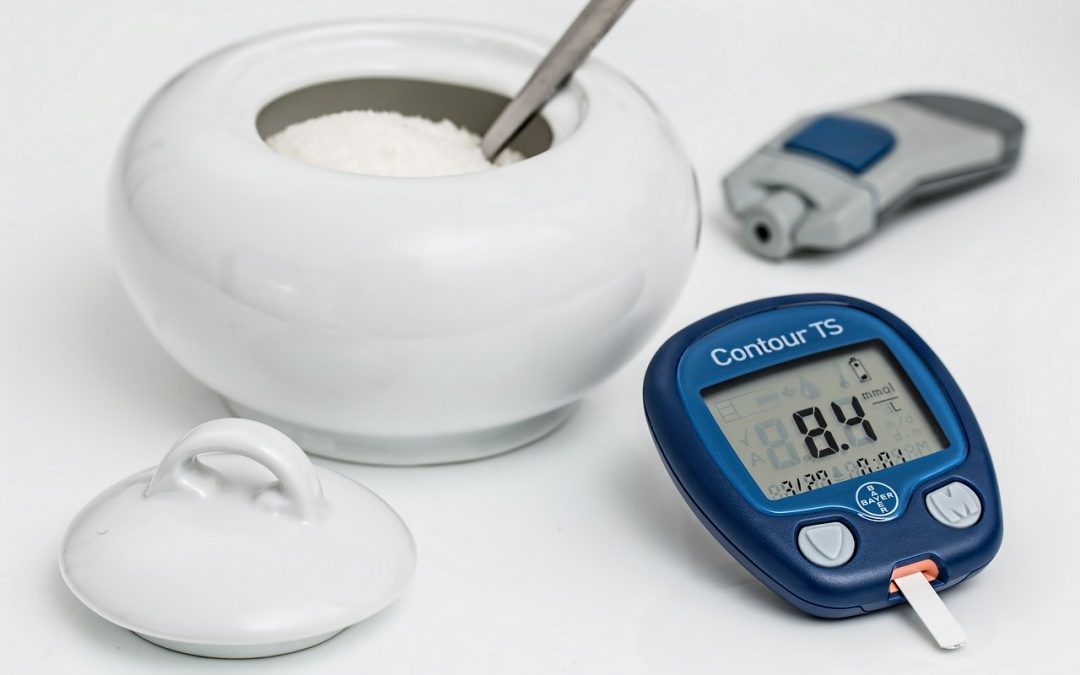
by dnshah | Mar 6, 2020 | Diet and Weight Loss, Health and Wellness Tips, Obesity, Stress Management
For those of us that want more control over our blood-sugar, did you know that our ability to handle sugar (“glucose tolerance”) goes down over the day? This means that the same amount of sugar eaten at 8am and eaten at 8pm causes a different fluctuation of blood sugar. The 8pm sugar dose may actually cause twice the response that the 8am dose does!
This can mean:
- A person who tests normal for diabetes in the morning, may not test normal mid-day. Something to consider if tested negative for diabetes but still have issues.
- Eating sugary foods at night creates a bigger sugar spike than if it had been eaten earlier in the day. So if you’re definitely going to eat sugar, have it early.
- Eating more food earlier in the day is actually better, since most carbohydrates convert to sugar. “Feast like a king in the morning and a pauper at evening”
- Breakfast skippers appear to be at a higher risk of developing type 2 diabetes, and have higher rates of heart disease/atherosclerosis in general. In a randomized test, breakfast skippers had about 10 point higher LDL (bad) cholesterol.
- Eating more calories earlier may have benefits! (better weight management, more weight loss, better blood-sugar control, and lower heart disease risks. On that note, it may be wiser to skip dinner than breakfast.

